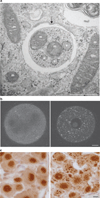Autophagy in mammalian development and differentiation - PubMed (original) (raw)
Review
Autophagy in mammalian development and differentiation
Noboru Mizushima et al. Nat Cell Biol. 2010 Sep.
Abstract
It has been known for many decades that autophagy, a conserved lysosomal degradation pathway, is highly active during differentiation and development. However, until the discovery of the autophagy-related (ATG) genes in the 1990s, the functional significance of this activity was unknown. Initially, genetic knockout studies of ATG genes in lower eukaryotes revealed an essential role for the autophagy pathway in differentiation and development. In recent years, the analyses of systemic and tissue-specific knockout models of ATG genes in mice has led to an explosion of knowledge about the functions of autophagy in mammalian development and differentiation. Here we review the main advances in our understanding of these functions.
Figures
Figure 1
Representative images of the induction of autophagy and the outcome of its suppression. (a) Electron microscopic analysis of mouse embryonic fibroblasts during nutrient starvation. Mitochondria (m) and fragments of endoplasmic reticulum (e) are observed inside an autophagosome (arrow). Mitochondria may be randomly sequestered under conditions of starvation, but can be selectively degraded during erythroid differentiation and Parkin-mediated mitophagy. Scale bar, 500 nm. (b) Induction of autophagy after fertilization. Unfertilized (left) and fertilized (right) oocytes from female mice expressing GFP–LC3 to monitor autophagosome formation were observed by confocal microscopy. Small dots indicate GFP–LC3-positive autophagosomes. Scale bar, 10 µm. (c) Accumulation of ubiquitin-positive inclusion bodies in neurons of Atg5-deficient mice. Dorsal root ganglion neurons from wild-type (left) and systemic Atg5-deficient (right) neonates were stained with a monoclonal anti-ubiquitin antibody (1B3, purchased from MBL). Scale bar, 10 µm.
Figure 2
The role of autophagy in development and differentiation in mammals. Autophagy has critical roles in fertilized oocytes and neonates through protein catabolism and the resulting production of the necessary amino acids. Autophagy is also important in cell remodelling (for example in mitochondrial elimination) during the differentiation of erythrocytes, lymphocytes and adipocytes. Finally, the role of autophagy in housekeeping is important, particularly in terminally differentiated cells such as neurons and hepatocytes, in which continuous renewal of cytoplasmic contents is essential.
Similar articles
- Focusing on autophagy.
[No authors listed] [No authors listed] Nat Cell Biol. 2010 Sep;12(9):813. doi: 10.1038/ncb0910-813. Nat Cell Biol. 2010. PMID: 20811352 No abstract available. - Glycogen autophagy in glucose homeostasis.
Kotoulas OB, Kalamidas SA, Kondomerkos DJ. Kotoulas OB, et al. Pathol Res Pract. 2006;202(9):631-8. doi: 10.1016/j.prp.2006.04.001. Epub 2006 Jun 16. Pathol Res Pract. 2006. PMID: 16781826 Review. - The role of autophagy in neonatal tissues: just a response to amino acid starvation?
Schiaffino S, Mammucari C, Sandri M. Schiaffino S, et al. Autophagy. 2008 Jul;4(5):727-30. doi: 10.4161/auto.6143. Epub 2008 Apr 17. Autophagy. 2008. PMID: 18437051 Review. - Hidden behind autophagy: the unconventional roles of ATG proteins.
Bestebroer J, V'kovski P, Mauthe M, Reggiori F. Bestebroer J, et al. Traffic. 2013 Oct;14(10):1029-41. doi: 10.1111/tra.12091. Epub 2013 Jul 30. Traffic. 2013. PMID: 23837619 Free PMC article. Review. - Endocytosis and autophagy: exploitation or cooperation?
Tooze SA, Abada A, Elazar Z. Tooze SA, et al. Cold Spring Harb Perspect Biol. 2014 May 1;6(5):a018358. doi: 10.1101/cshperspect.a018358. Cold Spring Harb Perspect Biol. 2014. PMID: 24789822 Free PMC article. Review.
Cited by
- The Novel Link between Gene Expression Profiles of Adult T-Cell Leukemia/Lymphoma Patients' Peripheral Blood Lymphocytes and Ferroptosis Susceptibility.
Wang Y, Iha H. Wang Y, et al. Genes (Basel). 2023 Oct 27;14(11):2005. doi: 10.3390/genes14112005. Genes (Basel). 2023. PMID: 38002949 Free PMC article. - Monocyte Chemoattractant Protein-Induced Protein 1 (MCPIP1) Enhances Angiogenic and Cardiomyogenic Potential of Murine Bone Marrow-Derived Mesenchymal Stem Cells.
Labedz-Maslowska A, Lipert B, Berdecka D, Kedracka-Krok S, Jankowska U, Kamycka E, Sekula M, Madeja Z, Dawn B, Jura J, Zuba-Surma EK. Labedz-Maslowska A, et al. PLoS One. 2015 Jul 27;10(7):e0133746. doi: 10.1371/journal.pone.0133746. eCollection 2015. PLoS One. 2015. PMID: 26214508 Free PMC article. - Lipid droplet turnover at the lysosome inhibits growth of hepatocellular carcinoma in a BNIP3-dependent manner.
Berardi DE, Bock-Hughes A, Terry AR, Drake LE, Bozek G, Macleod KF. Berardi DE, et al. Sci Adv. 2022 Oct 14;8(41):eabo2510. doi: 10.1126/sciadv.abo2510. Epub 2022 Oct 12. Sci Adv. 2022. PMID: 36223464 Free PMC article. - The role of autophagy during coxsackievirus infection of neural progenitor and stem cells.
Tabor-Godwin JM, Tsueng G, Sayen MR, Gottlieb RA, Feuer R. Tabor-Godwin JM, et al. Autophagy. 2012 Jun;8(6):938-53. doi: 10.4161/auto.19781. Epub 2012 Jun 1. Autophagy. 2012. PMID: 22751470 Free PMC article. - Macrophages monitor tissue osmolarity and induce inflammatory response through NLRP3 and NLRC4 inflammasome activation.
Ip WK, Medzhitov R. Ip WK, et al. Nat Commun. 2015 May 11;6:6931. doi: 10.1038/ncomms7931. Nat Commun. 2015. PMID: 25959047 Free PMC article.
References
- Mizushima N. Autophagy: process and function. Genes Dev. 2007;21:2861–2873. - PubMed
- Rubinsztein DC. The roles of intracellular protein-degradation pathways in neurodegeneration. Nature. 2006;443:780–786. - PubMed
- Mizushima N, Klionsky DJ. Protein turnover via autophagy: implications for metabolism. Annu. Rev. Nutr. 2007;27:19–40. - PubMed
Publication types
MeSH terms
Grants and funding
- U54 AI057156/AI/NIAID NIH HHS/United States
- R01 CA084254/CA/NCI NIH HHS/United States
- HHMI/Howard Hughes Medical Institute/United States
- R01 CA85254/CA/NCI NIH HHS/United States
- R01 CA109618/CA/NCI NIH HHS/United States
LinkOut - more resources
Full Text Sources
Other Literature Sources

